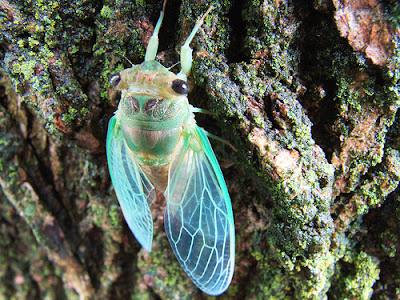After 17 years of patiently waiting underground, Brood X has begun to emerge with a vengeance, eager to populate our planet with their infernal buzzing (we actually like it). It may sound like the plot for War of the Worlds, but it is actually much more benign and very real. This spring and summer, cicadas will emerge in the billions from their underground burrows to begin a frantic and inelegant mating ritual. Who wouldn't want to cut to the chase after 17 years living in the dirt? For a few short weeks, the shrimp-sized insects create a cacophony of sound that can be heard quite clearly in urban and suburban environments alike. Cicadas are sometimes called locusts, but are unrelated to true locusts, which are grasshoppers. They are actually closely related to the more adorable leaf-hoppers and spittle bugs.
This must be like the Angelina Jolie of cicadas.
Scientists believe that the cicada's long nymph cycle is an adaptation that enables it to thwart predator populations. While many broods appear once every 1-8 years, the largest colonies only emerge once every 13 or 17 years (depending on the species), making it far more difficult for predator populations to adapt to preying on the cicada. That being said, the emergence of Brood X is a veritable smorgesboard for birds, rodents and insects. Scientists claim that it is nature's equivalent to all you can eat shrimp night at Red Lobster.
Cute as a button.

Devastation in Eastern Maryland...
Magicicada septendecim, Magicicada cassini, and Magicicada septendecula